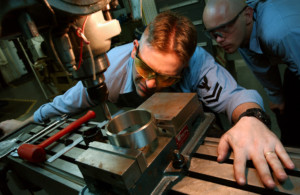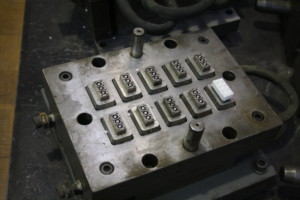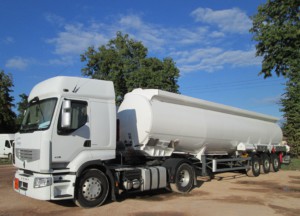 A good lot size has a significant impact on the performance of the system. In this second post, I look at the influence of the machine batch size on the lot size. I also briefly go into the lot sizes for the processing industry, and also administrative processes. In my next and last post I will look at how to manage different lot sizes in different parts of the value stream.
A good lot size has a significant impact on the performance of the system. In this second post, I look at the influence of the machine batch size on the lot size. I also briefly go into the lot sizes for the processing industry, and also administrative processes. In my next and last post I will look at how to manage different lot sizes in different parts of the value stream.
Machine Batch Size

Another influence of your lot size is the capacity of a machine, or the machine batch size. In many cases this is simple. Often, a machine can process exactly one part at a time, as for example the milling machine shown here. Hence, the machine itself can already do a lot size one.
However, there are other processes where the lot size may be larger than one. This may be, for example, an industrial oven for heat treatment that can fit multiple parts, or an injection molding machine that always makes multiple parts in the same shot, or any other kind of machine that makes multiple parts at the same time. Food processing often has one tank full of “food” for processing that is then filled into smaller packages. This tank is then your machine batch size.

However, the machine batch size does not automatically influence the lot size. It depends if the batch must be the same part. Imagine an industrial oven for heat treatment. You can fit a certain quantity in the oven, but the parts do not necessarily have to be of the same type. Unfortunately, they often do have to be the same type for process quality reasons. For example, you may fit a tray of muffins in the same oven where you are baking a turkey, but it won’t be good for either the turkey or the muffins 🙁 .

Even if the parts have to be of the same type, do you need to use the full capacity of the process? If an injection mold has 10 cavities for parts, it will be difficult to make only seven. However, an industrial oven may work with less-than-full capacity. Check with your process experts if this is possible or if this would require adjustments to the process to ensure consistent quality.
And, always remember, this machine batch size is a number you can influence when ordering new tools or machines. Often, two smaller ovens have a higher flexibility than one large oven.
About the Processing Industry
 Chemical processes are a bit trickier. First of all, what is a lot size of one in the processing industry? Is it one molecule? Certainly not! While you can measure your output in liters or kilos, you cannot “count” it. “How many water would you like to have?” … doesn’t work that way.
Chemical processes are a bit trickier. First of all, what is a lot size of one in the processing industry? Is it one molecule? Certainly not! While you can measure your output in liters or kilos, you cannot “count” it. “How many water would you like to have?” … doesn’t work that way.
If you fill it into containers for the end customer (e.g., jars of tomato sauce or buckets of paint), then you have your lot size again. “How many bottles of water would you like to have?” is now a valid question. If your process chain finishes with such an end-customer container, then you know again what a lot size of one is – although for economic reasons you may still produce in larger lot sizes than one.
 However, most chemical industry is for other industry, and the size of the delivery is much more flexible. In my experience the batch size in processing industry is determined by the size of the processing vessel. If your chemical reactor (or similar) can fit 500 liters, then that is what you will use as a lot size in most cases.
However, most chemical industry is for other industry, and the size of the delivery is much more flexible. In my experience the batch size in processing industry is determined by the size of the processing vessel. If your chemical reactor (or similar) can fit 500 liters, then that is what you will use as a lot size in most cases.
You may choose to reduce the lot size by filling the container to less-than-full capacity, but this usually is only sensible for exotic products or small orders. (E.g., if the customer orders only 50 liters per year in total, you will not make a 500 liter batch. However, I would recommend using a smaller vessel for this case.)
Overall, you can always use smaller processing vessels to increase flexibility and lead time. But, like with discrete products, there is no single right answer.
Also (and I will talk about this more in my next post), you do not have to use the same lot size throughout the entire process. You can decouple the process by having a larger storage tank/pile/container between processes, where you can change the lot size. Yet, this may not always be a good idea, since a) most chemical processes have much less steps than mechanical manufacturing, and b) many chemical products are subject to aging or may require traceability of the batch, which is incompatible with mixing old and new in a tank.
Overall, in most processing industries, the lot size is the size of the processing vessel. If multiple vessels are used in sequence, then the largest vessel usually determines the lot size.
 There is also processing industry that does not work in batches, but uses a continuous process. This could be, for example, a grain milling process or a rock crusher to produce gravel. In this case the changeover (both time and wasted product from cleaning) usually defines the lot size.
There is also processing industry that does not work in batches, but uses a continuous process. This could be, for example, a grain milling process or a rock crusher to produce gravel. In this case the changeover (both time and wasted product from cleaning) usually defines the lot size.
The approach is then similar to other manufactured products: involve your experts and nudge them to a lower lot size.
As with all other considerations so far, your lot size can be influenced here too! For batch processing you could organize a smaller batch. For continuous processing you could do a changeover workshop (a.k.a. SMED).
About Administrative Processes
 Administrative processes are also common in industry (and elsewhere). However, in my experience, the question of a good lot size rarely pops up. Most administrative processes have a lot size of one anyway, simply because every task is usually slightly different. If every task is slightly different, then it is not even possible to have a lot size larger than one.
Administrative processes are also common in industry (and elsewhere). However, in my experience, the question of a good lot size rarely pops up. Most administrative processes have a lot size of one anyway, simply because every task is usually slightly different. If every task is slightly different, then it is not even possible to have a lot size larger than one.
In fact, I had difficulties coming up with an example of larger lot sizes in administrative processes. But here’s one: When I grade the exams of my students, I do them in larger lot sizes. Actually, I grade all answers to question 1, then all answers to question 2, and so on. This way I reduce a “mental changeover” from question 1 to question 2 after every exam, and also achieve greater consistency (i.e., quality) in my grading.
Overall, administrative processes often have a lot size one anyway, simply because there are often no two tasks the same. If there are almost identical tasks, then the (mental or other) changeover time is the primary factor determining a larger lot size. The “size of the customer order” may also be of influence. But usually the administrative “lot size” is of much less importance than a manufacturing lot size.
I hope you enjoyed this second post of my series of three on lot sizes. My third and final post on lot sizes will look at the information flow and how to manage different lot sizes in different parts of the value stream. So stay posted. In the meantime, go out and organize your industry!
P.S.: This series of posts is based on a question from Curtis Rosché and Shaw Ma (for processing industry).
Post Overview:
- How to determine your Lot Size – Part 1: True North, Change over time, container size, shipment size, customer order size
- How to determine your Lot Size – Part 2: Machine batch size, process industry, administrative processes
- How to determine your Lot Size – Part 3: Information Flow: Decoupling and determining the lot size

Dear Prof. Roser,
How will we determine our lot sizes for stamping lines? Either you will do more inventory (big lots) with less setups which will make your accountants and manufacturing people very happy or you will do more setups and small lot sizes.
On your previous post you mentioned that we should always aim less inventory and one piece flow if possible and if it fits the reality. And in my company we have adjusted our lot sizes according to that rule. I mean, minimum inventory and maximum setup which grants for us holding only 2,5 days of inventory for our runner product in our stamping line kanban.
But my manager asks me what will happen if we already know that we will get a certain amount of orders (let’s say 300.000 pcs per month) and we do it with lot sizes of 100.000 instead of 3.000 pcs.
I can only tell to him that there are unmeasurable things like flexibility and problem solving culture but he keeps telling me that he is paying too much only to do “unnecessary” setups.
Great to see a comparison across industries, Christoph and very well explained again. Thank You.
Hi Hüseyin, if you get only a single order of one type of part, it may be possible to do this in one go, but there are still possible downsides: If your single order takes a long time, will it interrupt the other part flows, i.e. do you need more inventory of your other parts to cover the duration of this single order? In this case you may split the single order. Also, if you have pre-assemblies (Stamping: probably not), they may benefit from a more leveled demand and hence also benefit from a smaller order.
Hope this helps.
Chris.
An ideal lot size can do wonders in case of processes like metal or plastic injection molding. I think it majorly affects quality, timing and pricing of the overall project. One should consider this factor wisely before starting the production.